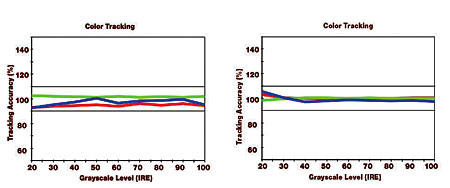Panasonic Viera TC-P42G10 Plasma HDTV HT Labs Measures
Black: 0.014
White: 25.97
Full-On/Full-Off Contrast Ratio: 1,855:1
All the measurements here, unless noted otherwise, were taken in the THX picture mode, through an HDMI input, with the set adjusted as needed for the most accurate within the requirements of the viewing tests in a darkened room.
The Panasonic had the next to the best black level and full-on/full-off contrast ratio in the group. While the Panasonic can produce a higher brightness level in other picture modes (as much as 80 foot-lamberts in Vivid), it looked best in our darkened room in its calibrated THX setting.

Due to a quirk in the calibration process and the fact that all the calibration controls are in a service menu, the Before Calibration settings shown here are for the Standard Picture mode and the After Calibration result is for a calibration in the THX mode—both of them in the Warm2 Color temperature setting. The Before Calibration result produced a Delta-E that ran from 3 to 9.1. (Delta-E is a figure of merit that indicates how close the color temperature comes to the ideal white point of D6500. The lower the number, the better. Experts generally recommend a maximum of between 3 and 4 for results that are visibly indistinguishable from lower values.) After calibration, it was 3.1 or less from 30 IRE to 100 IRE, increasing to 6.5 at 20 IRE.

The set’s color gamut, as shown by the white triangle on the CIE chart, is very close to the Rec.709 HD color gamut (the black triangle). The secondaries are slightly off, but less so than we often see. There’s a trace of oversaturation in red and green, but it’s hardly noticeable, and the red deviation isn’t deep enough to explain why only the Panasonic’s reds often looked crimson. The limited evidence (four sets versus one) suggests that the inaccuracy was in the Panasonic. But some panelists found it pleasing.

As you can see in the accompanying Video Test Bench chart, with the exception of the 2:2 HD test, the Panasonic passed all of our HDMI HD tests (including a single SD test of 480p-to-1080p scaling). However, it failed our M:I:III deinterlacing test on the Vatican wall (chapter 7) and was borderline on the stairs in chapter 8 of the same disc. But it did pass a separate test for component 1080i component horizontal resolution (not shown in the chart).—TJN
- Log in or register to post comments














































